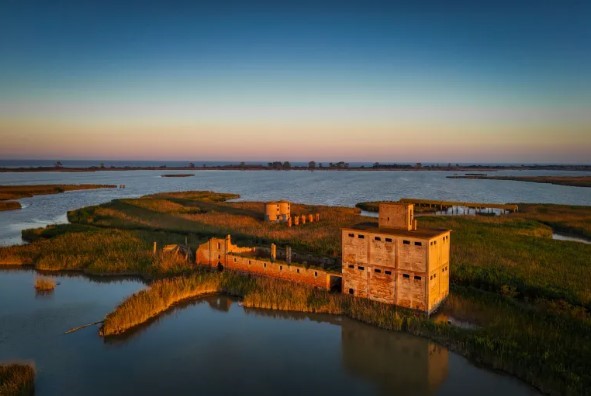
'The Sea Has Taken Everything': Italy's Po River Delta Reclaimed by the Adriatic
In the Po River Delta of northern Italy, farmers and residents are grappling with the encroaching Adriatic Sea, which has submerged landmarks and poisoned crops with salt. Only locals familiar with the shifting landscape dare to navigate the waters where the Po River meets the sea.
Subsidence, the gradual sinking of land, has dramatically altered the delta over the past 50 years. Entire coastal sections have disappeared, including the "Isola Bonelli Levante" in Porto Tolle, once a large rice farm now submerged and abandoned since the 1990s. Another example is the "Isola Batteria," a former World War II German fortification, now mostly a submerged lagoon with only skeletal remains of buildings.
The shallow, murky waters present a real risk for boats and kayaks guided by locals. The old riverbanks, where rice was once sown and fish caught, are now just a few reeds poking through the water. Luciano, a retired fisherman, reminisces, "I was born there. The sea has taken everything back."
The intrusion of saltwater is particularly concerning at the Po River's mouth, where it meets the Adriatic. This "salt wedge" can extend far inland, especially during dry summers. In 2022, it reached 40km (25 miles) inland, though it was less pronounced last year due to more rain. The rising salinity damages ecosystems and agricultural activities, as highlighted by ARPAE, the Emilia Romagna Agency for the Environment.
Several factors contribute to the increasing salt levels, including climate change-induced drought, reduced rainfall, and overuse of freshwater. Historically, the area was mined for methane gas until subsidence concerns halted operations in 1961. In the Po Delta, fields below sea level are particularly affected by salinization, posing a severe threat to agriculture.
Rodolfo Laurenti, deputy director of the Consorzio Bonifica Delta del Po, explains that irrigation water must have a salinity limit of one gram per liter. However, levels reached ten times this limit last summer in Taglio di Po, impacting crops such as rice, corn, and soy. In just two years, cultivable land in Polesine has decreased by over 30%, with rice production dropping by 20% last year.
The delta's rice fields, covering approximately 9,000 hectares, have been cultivated since the Middle Ages and hold a Protected Geographical Indication (PGI) status from the European Union. Rice growers like Elisa Moretto and Marco Uccellatori are increasingly worried. Moretto's farm output plummeted from 3,600kg to 900kg due to salinization. Uccellatori measures river water salinity daily to protect his crops.
To address these issues, the Consorzio Bonifica Delta del Po has installed barriers to manage water flow and prevent salt intrusion. These barriers, designed to handle the river's historical flow, are now less effective due to reduced rainfall and lower river flow. Laurenti mentions a new proposal for a barrier in the Po della Pila, which would improve freshwater flow for the entire delta.
In Emilia Romagna, scientists monitor rising salt levels through water samples from underground aquifers. Geologist Manuela Mengoni of ARPAE explains that increased salinity has been detected even in the shallow parts of the aquifer, indicating a troubling trend of saltwater intrusion.
As the sea continues to reclaim the delta, the region's farmers and residents face ongoing challenges to preserve their land and livelihoods against the advancing tide.